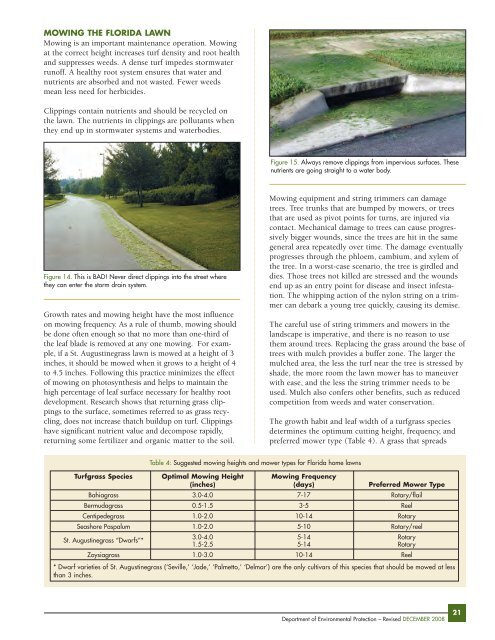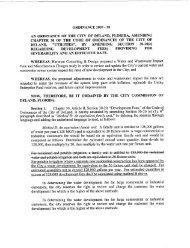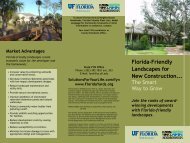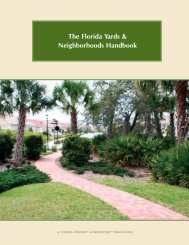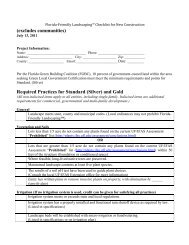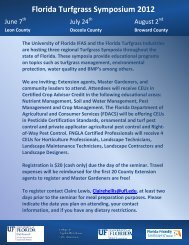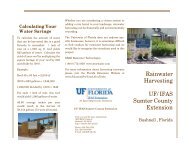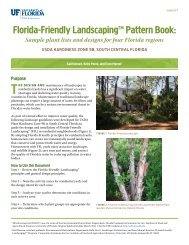Green Industries Best Management Practices manual
Green Industries Best Management Practices manual
Green Industries Best Management Practices manual
Create successful ePaper yourself
Turn your PDF publications into a flip-book with our unique Google optimized e-Paper software.
MOWING THE FLORIDA LAWNMowing is an important maintenance operation. Mowingat the correct height increases turf density and root healthand suppresses weeds. A dense turf impedes stormwaterrunoff. A healthy root system ensures that water andnutrients are absorbed and not wasted. Fewer weedsmean less need for herbicides.Clippings contain nutrients and should be recycled onthe lawn. The nutrients in clippings are pollutants whenthey end up in stormwater systems and waterbodies.Figure 15. Always remove clippings from impervious surfaces. Thesenutrients are going straight to a water body.Figure 14. This is BAD! Never direct clippings into the street wherethey can enter the storm drain system.Growth rates and mowing height have the most influenceon mowing frequency. As a rule of thumb, mowing shouldbe done often enough so that no more than one-third ofthe leaf blade is removed at any one mowing. For example,if a St. Augustinegrass lawn is mowed at a height of 3inches, it should be mowed when it grows to a height of 4to 4.5 inches. Following this practice minimizes the effectof mowing on photosynthesis and helps to maintain thehigh percentage of leaf surface necessary for healthy rootdevelopment. Research shows that returning grass clippingsto the surface, sometimes referred to as grass recycling,does not increase thatch buildup on turf. Clippingshave significant nutrient value and decompose rapidly,returning some fertilizer and organic matter to the soil.Mowing equipment and string trimmers can damagetrees. Tree trunks that are bumped by mowers, or treesthat are used as pivot points for turns, are injured viacontact. Mechanical damage to trees can cause progressivelybigger wounds, since the trees are hit in the samegeneral area repeatedly over time. The damage eventuallyprogresses through the phloem, cambium, and xylem ofthe tree. In a worst-case scenario, the tree is girdled anddies. Those trees not killed are stressed and the woundsend up as an entry point for disease and insect infestation.The whipping action of the nylon string on a trimmercan debark a young tree quickly, causing its demise.The careful use of string trimmers and mowers in thelandscape is imperative, and there is no reason to usethem around trees. Replacing the grass around the base oftrees with mulch provides a buffer zone. The larger themulched area, the less the turf near the tree is stressed byshade, the more room the lawn mower has to maneuverwith ease, and the less the string trimmer needs to beused. Mulch also confers other benefits, such as reducedcompetition from weeds and water conservation.The growth habit and leaf width of a turfgrass speciesdetermines the optimum cutting height, frequency, andpreferred mower type (Table 4). A grass that spreadsTable 4: Suggested mowing heights and mower types for Florida home lawnsTurfgrass Species Optimal Mowing Height Mowing Frequency(inches) (days) Preferred Mower TypeBahiagrass 3.0-4.0 7-17 Rotary/flailBermudagrass 0.5-1.5 3-5 ReelCentipedegrass 1.0-2.0 10-14 RotarySeashore Paspalum 1.0-2.0 5-10 Rotary/reelSt. Augustinegrass “Dwarfs”*3.0-4.0 5-14 Rotary1.5-2.5 5-14 RotaryZoysiagrass 1.0-3.0 10-14 Reel* Dwarf varieties of St. Augustinegrass (‘Seville,’ ‘Jade,’ ‘Palmetto,’ ‘Delmar’) are the only cultivars of this species that should be mowed at lessthan 3 inches.Department of Environmental Protection – Revised DECEMBER 200821


